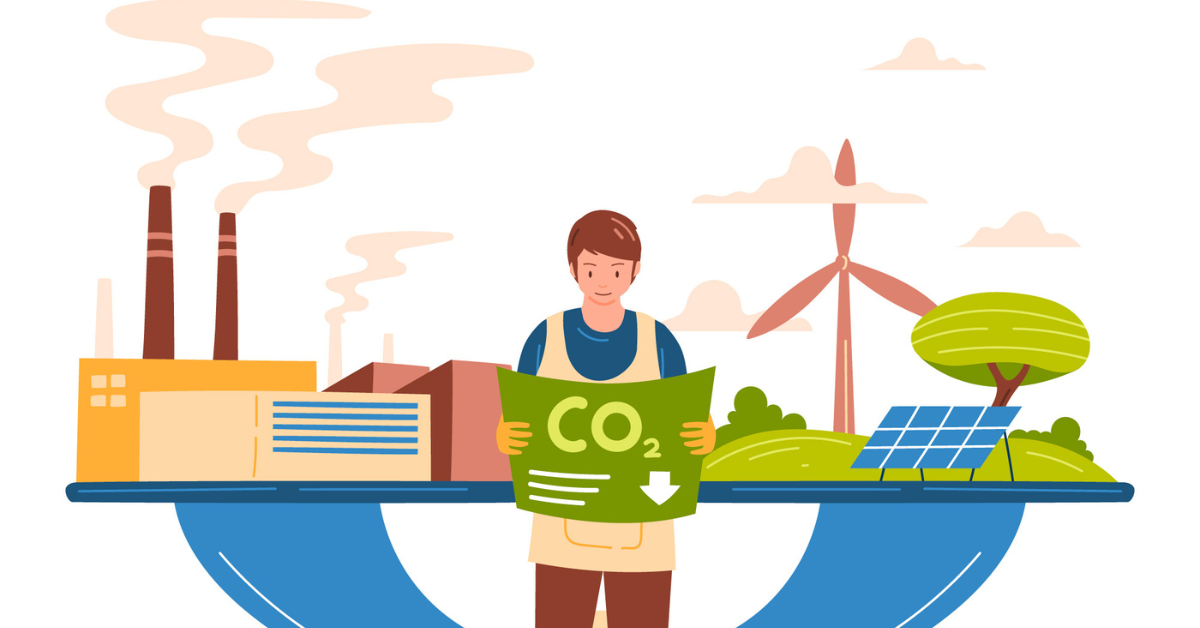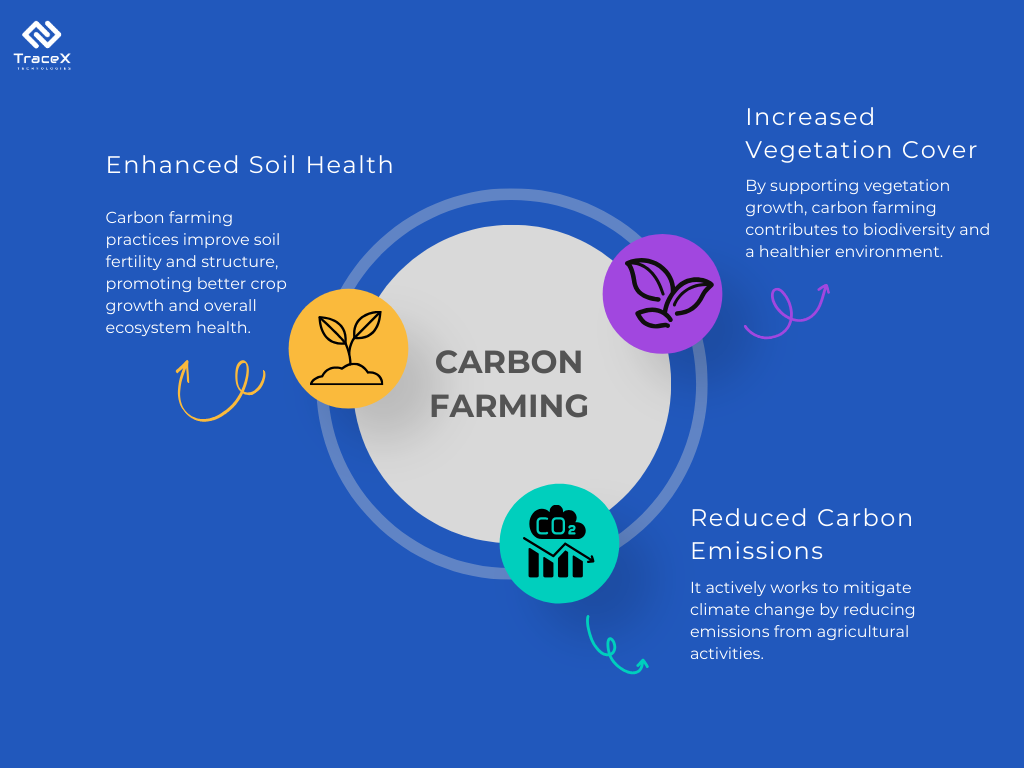Contact: +91 99725 24322 |
Menu
Menu
Quick summary: Explore how technology is transforming carbon farming in India! This blog dives into precision agriculture, digital platforms, and the role TraceX DMRV plays in enhancing data collection, verification, and market access for Indian farmers. Discover the potential of carbon farming to address climate change, improve soil health, and empower farmers.

The spectre of climate change looms large, casting a shadow on our planet’s future. Intensifying heatwaves, erratic rainfall patterns, and rising sea levels are stark reminders of the urgent need for sustainable practices across all sectors, particularly agriculture – a major contributor to greenhouse gas emissions. Carbon farming in India offers a ray of hope. It’s a suite of agricultural practices designed to capture atmospheric carbon dioxide (CO2) and store it in the soil, mitigating climate change’s impact.
While the core principles of carbon farming are straightforward – improve soil health and carbon storage – traditional methods often lack precision and data-driven insights. This is where technology steps in, bridging the gap between traditional practices and a future of efficient, data-driven carbon farming in India.
India’s agricultural sector, a critical pillar of the economy and a source of income for millions, faces a crossroads. Traditional methods, reliant on water and often unsustainable, struggle to adapt to changing climate patterns and market demands. The need for a shift towards sustainable agriculture is undeniable.
Carbon farming is a promising solution with the potential to address these challenges. It’s a comprehensive approach that captures atmospheric carbon dioxide (CO2) and stores it in soil and vegetation. Essentially, it aims to sequester more carbon than is released, leading to a net reduction in CO2 levels.

Practices like agroforestry, no-till farming, and cover cropping are gaining traction in India. These methods represent a significant step towards sustainable agriculture, with the potential to improve environmental conservation and build resilience within the agricultural sector.
In essence, carbon farming presents a win-win situation for India. It can address environmental concerns while strengthening the agricultural sector, a vital source of livelihood for millions.
India’s vast agricultural land, spanning over 170 million hectares, presents a golden opportunity for economic growth through carbon farming. This approach could unlock an estimated $63 billion by implementing practices that capture carbon dioxide from the air and store it in the soil.
Carbon credit systems create a market where farmers can be financially rewarded for their environmental contributions. By adopting carbon-friendly practices, they can sequester significant amounts of carbon dioxide (estimated at 3-8 billion tonnes annually over 20-30 years) and earn income by selling carbon credits to companies looking to offset their emissions.
While fertile regions like the Indo-Gangetic plains and the Deccan Plateau are ideal for carbon farming practices, other areas like the Himalayas and coastal regions require specific approaches. Understanding these regional variations is crucial to maximize the success of carbon farming initiatives across India.
The rise of carbon farming in India presents exciting business opportunities. One area is developing technologies to verify carbon credits, requiring accurate measurement of soil carbon content. Another is creating new agricultural materials like bio-pesticides and carbon-storing crops. Existing agrochemical and seed companies are well-positioned to capitalize on this.
However, maintaining crop yields is crucial. Technologies that help farmers maintain yields with reduced fertilizer use are in high demand. Financial incentives beyond carbon credits are also valuable. One approach is creating a value chain connecting carbon farmers with premium-paying consumers. Sustainable finance offering preferential interest rates for carbon farming projects is another possibility.
With its massive agricultural land (nearly 170 million hectares) and immense potential for capturing and storing carbon, India stands as a crucial player in the global carbon farming market. Estimates suggest each hectare of Indian farmland could achieve emission reductions of 3 metric tons of CO2 equivalent annually. This translates to a potential market exceeding US$5 billion, assuming a carbon credit price of $10 per ton.
Beyond economic benefits, carbon farming offers solutions to India’s pressing environmental and social challenges. Current agricultural practices contribute to greenhouse gas emissions, air pollution, and water shortages. Additionally, excessive fertilizer use threatens food security. The beauty of carbon farming lies in its ability to address all these issues simultaneously.
While South America and Southeast Asia dominate the traditional forest carbon credit market (through activities like afforestation), India, with its vast farmland and potential for substantial environmental improvements, is poised to become the global leader in carbon farming credits.
Despite the promising potential of carbon farming in India, there are several hurdles that need to be addressed to ensure its widespread adoption:
Many farmers lack a clear understanding of carbon farming practices, their benefits, and the long-term impact on their land and income. Some farmers might be sceptical of new concepts and hesitant to change established practices. Distrust of external interventions can also hinder adoption.
Implementing certain carbon farming practices, like cover cropping or adopting new technologies, may require upfront investments that some farmers cannot afford. The long-term nature of carbon sequestration makes it difficult for farmers to assess potential financial returns from carbon credits, leading to risk aversion.
The voluntary carbon market in India is still in its nascent stage, and access to reliable carbon credit buyers can be challenging for farmers, especially smallholders. The process of verifying the amount of carbon sequestered can be expensive, further reducing potential profits for farmers.
Traditional methods for monitoring soil health and carbon sequestration can be time-consuming and lack precision. The lack of access to technology and digital literacy among smallholder farmers can hinder their ability to participate in data-driven carbon farming practices.
The current policy framework for carbon farming in India is still evolving, creating uncertainty for farmers and businesses considering investment.
Limited government incentives for carbon farming practices can discourage widespread adoption by farmers.
The rise of carbon farming in India presents a unique opportunity, but traditional methods often lack the precision and data-driven approach needed for optimal results. This is where technology steps in, transforming carbon farming into a data-powered practice that maximizes carbon sequestration and empowers farmers.
1. Precision Agriculture and Data Collection:
The foundation of technology-driven carbon farming lies in precision agriculture. This utilizes various tools to gather detailed information about a farmer’s land:
2. Digital Platforms and Monitoring: Connecting Farmers and Verifying Results
Beyond data collection, technology plays a crucial role in connecting farmers with the broader carbon market ecosystem:
Digital MRV platforms enhance transparency within the carbon market. Farmers have clear access to their data, understand how practices contribute to carbon sequestration, and can confidently navigate the verification process. This builds trust among all stakeholders – farmers, carbon credit buyers, and consumers.
As the world embraces carbon farming, ensuring accurate measurement and verification of carbon sequestration is critical. TraceX DMRV steps in as a game-changer, offering a user-friendly digital platform specifically designed for this purpose. TraceX empowers farmers by simplifying data collection through mobile and web apps, even integrating with remote sensing technologies like satellite imagery. This eliminates the burden of complex data management and provides valuable technical guidance on carbon farming practices. For the broader market, TraceX fosters trust and transparency by streamlining verification processes for carbon credit buyers. By equipping farmers and ensuring the integrity of carbon credits, TraceX paves the way for a robust carbon farming market in India.
In conclusion, technology is the missing piece that unlocks the full potential of carbon farming in India. By providing farmers with precision tools for data-driven decision making, connecting them with carbon markets, and ensuring transparency through platforms like TraceX DMRV, technology empowers farmers and fosters trust within the market. This paves the way for a future where Indian agriculture becomes a climate-friendly powerhouse, contributing to global sustainability efforts while bolstering food security and farmer livelihoods. With a focus on continuous innovation and inclusive access to technology, India can truly become a global leader in the carbon farming revolution.
